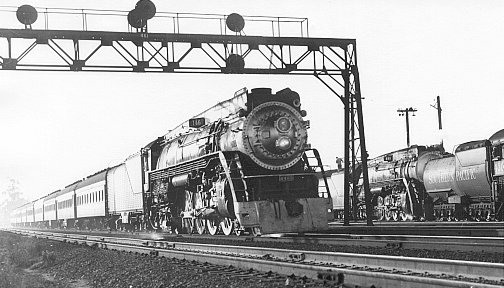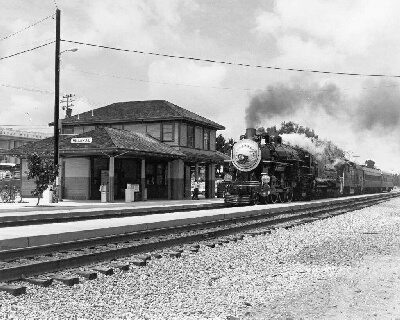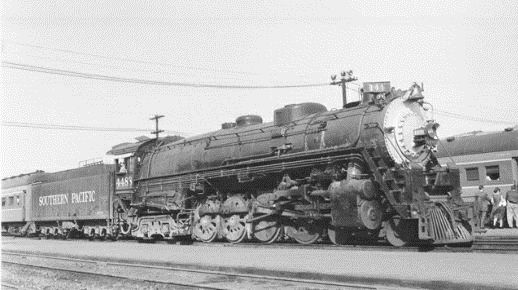
SP GS-4 4453 races past
Lenzen Avenue Roundhouse in San Jose only moments from it's final destination.
(Rattenne Collection)

By the late 1930s and
early 1940s, 4-6-2 Pacific type locomotives were assigned to the heavier
peak- hour trains. Above, 2479 at an undisclosed location. In 1958 2479
was donated to Santa Clara County and placed on display at the fairgrounds.
Today the Pacific is under restoration. (Rattenne Collection)

Former SP 2472 races
past the historic Milbrae depot during a break-in run in 1991. As additional
4-8-2s arrived on SP, more 4-6-2s were assigned to commute service (GGRM)

This is about as
rare a steam incident as you could get on the latter-day SP. SP 4488 is
at Third and Townsend in the late afternoon of a 1956 summer day. Northern
4488 is ex-SSW 813, built by the SSW shops at Pine Bluff in 1937. Retired
11-13-58, and scrapped by Luria Bros., the 4488 ran only a few weeks in
commute service. (Rattenne Collection)
|
by
Don Douglas
The history of commute trains
on the San Francisco Peninsula is long and colorful. In January 1851 a
line connecting the trading center of San Francisco with California's first
state capital, San Jose, was first proposed by Judge Davis Divine. The
sum of $100,000 was raised, but the scheme fizzled when the site of the
capital was moved to Vallejo. In September 1851 the Pacific & Atlantic
Railroad, incorporated to run between San Francisco and San Jose, and coast-to-coast
thereafter, was incorporated. Unfortunately, lack of funding doomed it
and two subsequent ventures before ground was ever broken.
In 1860 the San
Francisco and San Jose Rail Road was incorporated. Financing for a railroad
between the two cities came from three counties --San Francisco, San Mateo
and Santa Clara. In May 1861 ground was broken at San Francisquito Creek
between Palo Alto and Menlo Park and five construction camps were set up
to start work. In October 1863 regular service between San Francisco and
Mayfield (now the California Avenue section of Palo Alto) began. The trip
took two hours. At Mayfield, passengers boarded a stagecoach to get to
San Jose.
On January 16, 1864 the
line was completed to San Jose.. More than 2,000 people attended the ceremony
marking completion of the line. Within a short time, two trains operated
each weekday between San Francisco and San Jose. In 1870 the SF&SJ
Railroad was absorbed into the Southern Pacific, controlled by the "Big
Four" -Leland Stanford, Collis P. Huntington, Charles Crocker and Mark
Hopkins. In 1907 the Bayshore Cutoff, a 10-mile line which bypassed the
original route through San Bruno and the present Daly City was completed.
The opening of the railroad
down the Peninsula brought a whole new population of well-to-do San Franciscans
who built homes along the Peninsula. Word of the Peninsula's mild, even
climate and protection from heavy winds and fog caused more and more San
Franciscans to move south and by 1900 commute trains on the Peninsula allowed
residents to commute to jobs in San Francisco. A big boom in Peninsula
population took place following the April 18, 1906 San Francisco Earthquake
and fire.
Population growth continued
at a reasonable rate during the teens and twentys, and slowed during the
depression years of the 1930s. By the end of World War II, California's
population exploded as more and more people moved west. During this period
more and more housing subdivisions were being built along the Peninsula,
starting in the Millbrae area and moving south toward San Jose. By the
mid-1950s the Peninsula was wall-to-wall housing and shopping centers from
San Francisco south to San Jose.
The growth in population
along the Peninsula resulted in longer and longer commute trains along
Southern Pacific's commuter line. As the population increased along the
Peninsula route, the old Bayshore Highway, 101, was slowly rebuilt to a
freeway and, while these highway improvements resulted in some loss in
commuters on Southern Pacific, the railroad was still carrying a respectable
number of people commuting to work in San Francisco.
Early commute trains on
the Peninsula were powered by a variety of power, including 4-4-0s, 2-6-0s
and 4-4-2s. As trains became longer and heavier, 4-6-0s were assigned to
the commute trains. By the late 1930s and early 1940s, 4-6-2 Pacific type
locomotives were assigned to the heavier peak- hour trains. These Pacifics
were originally purchased for main line passenger trains with the first
ones, 2400-2404, built by American Locomotive Company in 1904, followed
by 2405-2427 built by Baldwin in 1906 and 1907.
By the mid-1920s, SP's
main line passenger trains were becoming longer and heavier and required
larger locomotives. Between 1923 and 1924 Schenectady delivered twenty-eight
4-8-2s, 4300-4327, which were assigned to the main line passenger trains,
which released the smaller Pacifics for secondary, branch line and commute
service.
As additional 4-8-2s arrived
on SP, more 4-6-2s were assigned to commute service replacing smaller Ten
Wheelers. - In 1930 SP received its first 4-8-4s, Nos. 4400-4409 built
by Baldwin. This order was followed by additionaI4-8-4s from Lima in 1937
as numbers 4410-4429 arrived. Originally assigned to the Coast Daylight
and other passenger trains, these 4-8-4s replaced 4-8-2s which were
re-assigned to secondary passenger service and general freight service.
Between 1941 and 1943 additional4-8-4s numbered 4430-4469 arrived from
Lima.
By the end of World War
II the 4-8-2s were assigned to the peak-hour commute trains with 4-6-2s
handling the off-peak trains, while a few 4-6-Os worked the short weekend
commute trains. In the early 1950s the commute trains continued to grow
with 17-car peak-hour runs requiring larger motive power. At that time
the SP was well on the way to dieselizing its main line passenger trains
with EMD E and Alco-GE PA units. These diesels replaced the 4-8-4s on a
number of passenger runs, which resulted in several 4-8-4s being assigned
to the heavy commute trains.
|

